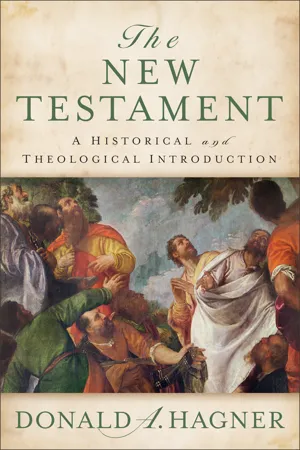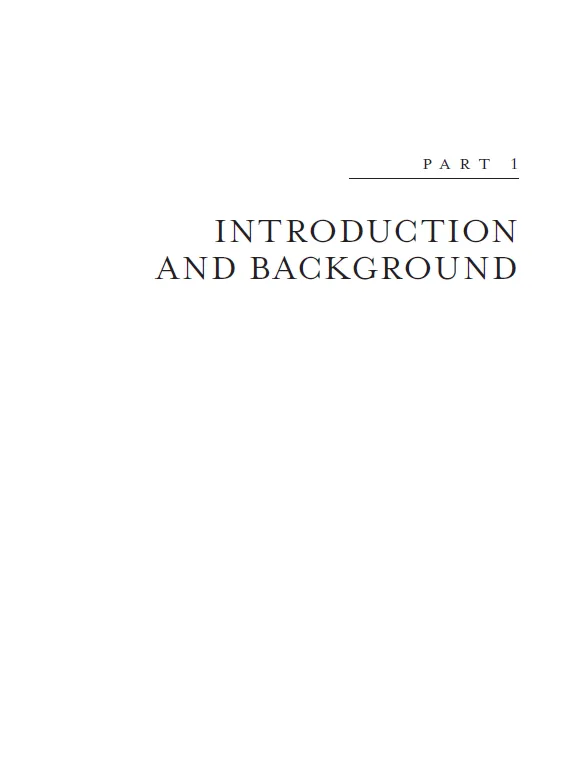![]()
![]()
1
Approaching the New Testament
as the Church’s Scripture
The Bible is God’s gift to the church. Its contents are acknowledged by the church as uniquely inspired by God and revealed to human authors through the inspiration of the Holy Spirit. The NT provides the church not only with the founding story of its incarnate Lord and the salvation accomplished by him but also with a key provision for its ongoing sustenance and guidance. For the church, therefore, Scripture is unique, holy, and possesses irreplaceable, infallible, canonical authority.
The church fully depends on the historical events narrated especially in the Gospels: the ministry, death, and resurrection of Jesus. The Christian faith is more than ethics or philosophy: it rests squarely on the reality of historical events. Our salvation, as magnificent and transcendent as it is, was accomplished in datable time and locatable space. The notice in Luke 3:1–2, at the beginning of the story, could hardly be more specific in terms of historical particularity: “In the fifteenth year of the reign of Tiberius Caesar, Pontius Pilate being governor of Judea, and Herod being tetrarch of Galilee, and his brother Philip tetrarch of the region of Ituraea and Trachonitus, and Lysanias tetrarch of Abilene, in the high-priesthood of Annas and Caiaphas, the word of God came to John the son of Zechariah in the wilderness.”
Although Christianity transcends the historical, it is inseparable from the historical. “There cannot therefore be any proclamation of the gospel which is not at the same time a narration of past history.” The historical basis of the Christian faith is at once its glory and stumbling block. The glory is in the fact that in the biblical story God enters history, so to speak, for the purpose of rescuing his creation. The eternal intersects the temporal. The stumbling block is that history is fragile: full of uncertainties and subject to human investigation and human doubt. But Christianity nevertheless depends squarely on its contradiction of the famous “ditch” that the eighteenth-century German philosopher G. E. Lessing dug between transcendent truth and the vagaries of history.
The Scriptures as Historical Documents
If the story of salvation is above all a historical story, so too the documents of the NT that record that history are documents that originate in history. The NT did not drop out of heaven directly from God, untouched by human hands. On the contrary, its writings are the products of particular human beings, who lived in specific times and places, and who had their own personalities and their own distinctive viewpoints. Nor were these authors simply empty channels, passively receiving supernatural dictation. As God came to us through the agency of a human being, Jesus, so in an analogous way the word of God comes to us through the agency of human words. This is of the essence of Christianity, and it is of the utmost importance. Thus the record and interpretation of the saving acts of God contained in the NT is itself a collection of historical data, mediated by and through history. Scripture consists of a deed/word or event/interpretation complex where every aspect comes to us through historical means. Indeed, there is a sense in which we may say that God has entrusted the whole process of salvation to history: not merely the acts of redemption themselves, but their record and interpretation in the writing of Scripture, in the formation of the canon, and in the transmission of the text. Theology and history remain inseparably bound together.
This single lapidary fact—the inspired word of God comes to us through the medium of history, through the agency of writers who lived in history and were a part of history—necessitates the historical and critical study of Scripture. It is the reason for the writing of the kind of book you have in your hands. In no other way than by historical study can we come to an adequate understanding of the Bible that honors it as God has been pleased to give it to us.
Biblical Criticism
Unfortunately, the words “criticism” and “critical” are often misunderstood. As used here, the words do not refer to criticizing Scripture—that is, tearing it down or demeaning it—but rather to exercising judgment or discernment concerning every aspect of it. As I use them here, the words indicate nothing other than the good use of reason and the various tools available in understanding and interpreting the Bible. Criticism in this sense is not an option but an absolute necessity if one is going to make any intelligent statement about the Bible or to begin to interpret it responsibly. The question is not whether we should engage in criticism—if we do not, we will be forced to keep silent about the Bible—but whether our critical judgment is good or bad, well founded or without justifiable basis. Studying the Bible critically may be conceived as one way of loving God with all our mind, as we are directed by Jesus, who cites the Shema as the first and greatest commandment (Matt. 22:37, citing Deut. 6:5).
We must engage in historical criticism, in the sense of thoughtful interpretation of the Bible, both because of the way in which God has given Scripture to us and because of its intrinsic nature. To approach the Bible in any other way is to be untrue to its nature. We are called to deal with the Bible that God gave to us, and as God gave it, not as we might suppose or wish it to be.
The historical method is indispensable precisely because the Bible is the story of God’s acts in history. The salvation-historical narrative that begins in Genesis comes to its climax in the NT account of the appearance of Jesus of Nazareth, the Son of God, at a specific time and place. Since the records and narratives of these salvation-historical acts of God in the Bible are themselves products of history, written by individuals located in specific times and places, it is vitally important to immerse ourselves in the history of that era and that culture. If we are to understand these things, they must be studied historically, using the tools and methods of historical research.
For sincere, believing Christians, the word “critical” therefore should be regarded as a good word, and it will be used as such in this book. Only “radical” criticism—that is, a hostile, destructive approach to Scripture—is problematic for faith.
Historical Method and Presuppositions
The main problem with radical, destructive criticism is not the application of critical judgment to Scripture but rather its unjustified presuppositions.
Thus, unfortunately, a feigned neutrality more often than not hides an a priori negative bias. As Colin Hemer notes, “The Enlightenment imposes, not freedom from presupposition, but contrary presuppositions.” A naturalistic worldview, which is not subject to proof and can only be presupposed, rules out the possibility of the transcendent or supernatural and thus necessarily closes the mind of the scholar to the truth of the Bible’s narratives. Hypotheses built on this presupposition are precarious at best. Many indeed contend that such an attitude is required if one is to practice the historical-critical method with integrity. But Martin Hengel’s advice is worth listening to: “The most appropriate attitude for the scholar when dealing with the historical narratives of the New Testament is one which does not disregard a priori the testimony and the claim presented in these texts, but is prepared to ‘listen’ openly to what they have to say. Such an approach takes seriously the content of the texts—however strange they may seem to us—and attempts to understand them in terms of their intrinsic concerns. This also involves accepting, rather than denying, their claim to be kerygmatic historical reports.”
It is the bread and butter of the historian to work with causation in history. But historians have no access to the divine causation that is so fundamental to the biblical narratives, a causation outside the closed network of perceivable cause and effect. However, this need not paralyze the historian’s critical judgment. Other matters are indeed accessible to the historian, such as the nature and reliability of the evidence, the identity and credibility of the witnesses, and their proximity to the event in question. Purged from unjustifiable presuppositions, the historical-critical method provides wonderful tools to help us understand the Bible.
Keeping an open mind concerning the possibility of the transcendent in history does not entail the suspension of critical judgment. There is no need for a naive credulity and acceptance of anything and everything simply because one’s worldview is amenable to the supernatural. A method, however, that excludes the supernatural from the start will not take us far in understanding documents that find their very raison d’être in the activity of God in history. It would be hard to devise a worse match than so-called scientific (= naturalistic) historiography and the Bible, where the method itself cancels out its subject matter a priori. It should be no surprise that this approach has been so unproductive. But as N. T. Wright stresses, “There are more things in heaven and earth than are dreamed of in post-Enlightenment philosophy, as those who have lived and worked in areas of the world less affected by Hume, Lessing and Troeltsch know quite well.” The critical method therefore needs to be tempered so that rather than being used against the Bible, it is open to the possibility of the transcendent or miraculous within the historical process and thus is used to provide better understanding of the Bible.
The Spurning of the Historical-Critical Method
Paradoxically, at present it is not only some very conservative scholars who have turned away from the critical method but also more reasonable and even liberal scholars who recognize that the method, as usually practiced, is bankrupt if not dead. Quite remarkably, in recent years the whole enterprise of traditional historical-critical scholarship has come into disrepute. The move away from exclusively historical and theological questions began gently enough with the application of new disciplines to the study of the Bible. Preeminently one thinks of sociology and anthropology, rhetorical and narrative criticism, and especially the new appreciation of the Bible as literature. Although...

